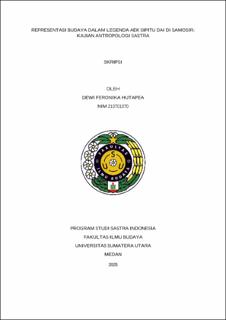Representasi Budaya dalam Legenda Aek Sipitu Dai di Samosir: Kajian Antropologi Sastra
Cultural Representation in The Legend Of Aek Sipitu Dai in Samosir: a Literary Anthropological Study

Date
2025Author
Hutapea, Dewi Feronika
Advisor(s)
Harahap, Nurhayati
Riyanto, Bambang
Metadata
Show full item recordAbstract
Literature is a personal expression of human experiences or thoughts conveyed through either oral or written forms. Legend is one form of oral literature that reflects local cultural values. This study aims to reveal the cultural representations embedded in the legend of Aek Sipitu Dai from Samosir, North Sumatra, and how the legend reflects the value system and cultural identity of the Batak Toba people. The research adopts a literary anthropology approach using Koentjaraningrat’s theory of the three cultural forms: culture as ideas, as activities, and as artifacts. The findings show that the Aek Sipitu Dai legend serves not only as oral heritage or entertainment but also as a medium for transmitting sacred, social, and historical cultural values. Culture as an idea is represented in the community's belief in the sacredness of the Aek Sipitu Dai spring and its connection to ancestors and the Dalihan Na Tolu system. As an activity, culture is reflected in customary rituals such as marpangir, welcoming guests with tortor dance, and the daily traditions that are still preserved. As an artifact, cultural representation appears through the existence of the Seven-Flavored Fountain (Pancuran Tujuh Rasa), Batu Paranggir-anggiran, Batak Gorga carvings, and the Parhutuan stone paintings, all of which carry philosophical and symbolic meanings. Overall, these findings emphasize that the Aek Sipitu Dai legend plays a crucial role in shaping and preserving the cultural construction of the Batak people across generations and forms a core part of safeguarding local cultural heritage.
Collections
- Undergraduate Theses [617]
